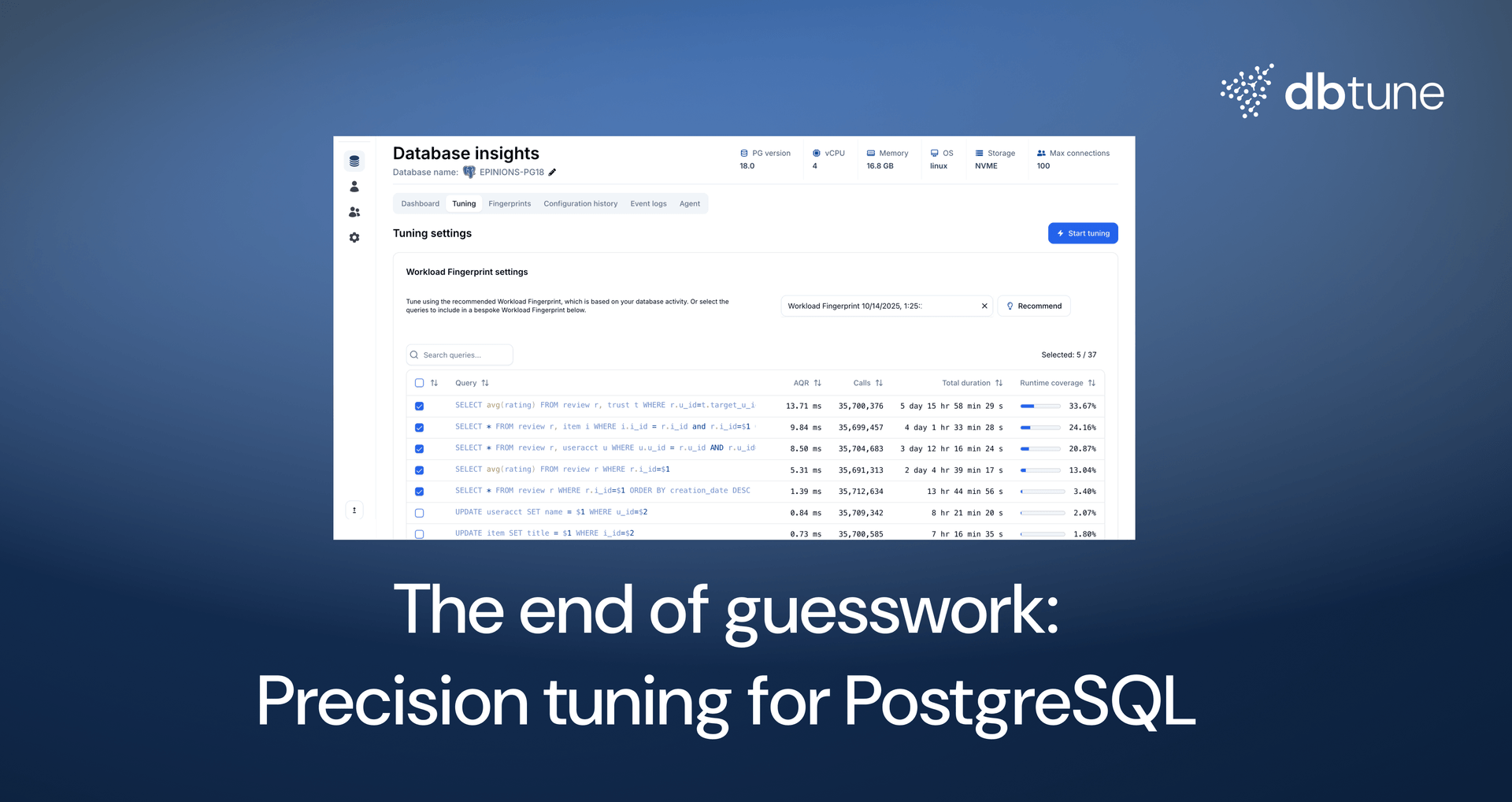The end of guesswork: Precision tuning for PostgreSQL
DBtune announces Workload Fingerprints, a groundbreaking method that brings precision and engineering to PostgreSQL performance tuning.


DBtune announces Workload Fingerprints, a groundbreaking method that brings precision and engineering to PostgreSQL performance tuning. Workload Fingerprints transform what was once an unpredictable process into a repeatable, data-driven process, enabling real performance improvements for databases of all sizes and complexities. Performance tuning of the future is human-guided and AI-accelerated.
The Workload Fingerprint method offers PostgreSQL users a fundamentally new way to measure performance. It transforms the often-unpredictable process of tuning into a consistent, data-driven engineering practice, powered by our proprietary generative AI technology. This capability is critical because traditional metrics, like Average Query Runtime (AQR), are easily skewed by workload variations and runtime noise, making it a challenge to truly quantify performance gains.
- Stable, reliable metric: The Workload Fingerprint method automatically identifies the most performance-critical queries, based on runtime and frequency, and focuses tuning efforts exclusively on them, providing a stable, reliable Key Performance Indicator (KPI).
- AI-accelerated tuning: DBtune’s optimization engine uses this precise data to custom-tailor server parameter optimizations, delivering predictable, measurable results that translate directly into consistent performance, stability, and efficiency gains for DBtune users.
This feature is a major leap forward for the PostgreSQL community and further solidifies DBtune's leadership in delivering AI-powered database optimization to engineering teams.

The role of Workload Fingerprints in the age of AI agents
While the Workload Fingerprint method provides the robust measurement you need, the true power comes from how AI agents can use this data. DBtune’s optimization engine analyzes the Workload Fingerprint to understand your database's unique performance profile. It then automatically tunes PostgreSQL server parameters, custom-tailoring each optimization to your specific workload and hardware. The robust data cleaning pipeline enabled by Workload Fingerprints allows DBtune to deliver measurable performance improvements while freeing your teams from manual, time-consuming analysis.
From "art" to engineering
Workload Fingerprints transform traditional tuning by providing a methodology to performance measurement. Instead of relying on a generalized Average Query Runtime (AQR) or high-level TPS, this new feature allows you to:
- Define your target workload: You can focus on the specific queries that matter most to your application's performance. DBtune's engine analyzes queries based on both their response time and call frequency, and provides automatic recommendations.
- Create a robust measurement: You get a single, stable performance metric that isn't susceptible to large variations in query distribution or runtime noise — See figure below.
- Guide your tuning decisions: The Workload Fingerprint performance can be used as a reliable KPI to compare different performance measurements and validate your tuning efforts.
By handling data-intensive and repetitive tuning work with AI, your team is able to focus their energy on what they do best — applying business context and institutional knowledge to tuning decisions and building new applications. Workload Fingerprints transforms tuning from a manual and arduous journey into an accelerated and consistent process driven by performance measurement.
Stable Workload Fingerprint performance in a real-world scenario

In a real-world scenario, fingerprint performance shows much lower variability than average query runtime. This gives a clearer signal for DBtune to optimize and for you to understand.
What this means for you
This new feature helps you:
- Focus on what matters: Tune for the queries that have the biggest impact on your application's performance according to your business priorities.
- Get a clear signal: See the measurable effect of your changes with a robust, stable performance metric.
- Save time and resources: Stop chasing misleading metrics and start making efficient, targeted tuning adjustments.
Our feature translates the art of performance tuning into a reproducible engineering process, helping you achieve better, more predictable results.
Ready to see how Workload Fingerprints can help you? Find out more in our technical documentation, our PGConf NYC presentation, contact us directly, or try it out for yourself.
Q&A
What is a Workload Fingerprint?
Workload Fingerprinting is a robust and repeatable method for measuring PostgreSQL performance. It identifies the most relevant queries that characterize an application’s performance during a well-defined measurement window. This data-driven approach allows us to address the instability of traditional metrics collection approaches, like Average Query Runtime (AQR) or Transactions Per Seconds (TPS), which can be skewed by noise and variations in query mix.
What are the main benefits of using Workload Fingerprints?
Using Workload Fingerprints helps you focus on the queries with the biggest impact on performance, provides a stable metric to see the effect of your changes, and saves time by allowing you to make efficient, targeted tuning adjustments. By leveraging a data-driven metric the engineering team can focus their efforts with more precision and predictability.
How is a Workload Fingerprint different from traditional tuning?
Unlike manual tuning, which often reacts to existing problems, the Workload Fingerprint method can be used proactively to optimize the database and reduce the risk of costly downtime. It transforms tuning from an unpredictable "art" into a repeatable, data-driven engineering process, freeing your teams from guesswork and manual analysis. The context and expertise of your team is accelerated with the help of AI.
How do I get started with Workload Fingerprints?
Workload Fingerprints are a feature of the DBtune platform. You can learn more by visiting the DBtune website or exploring the resources on their blog and GitHub.
